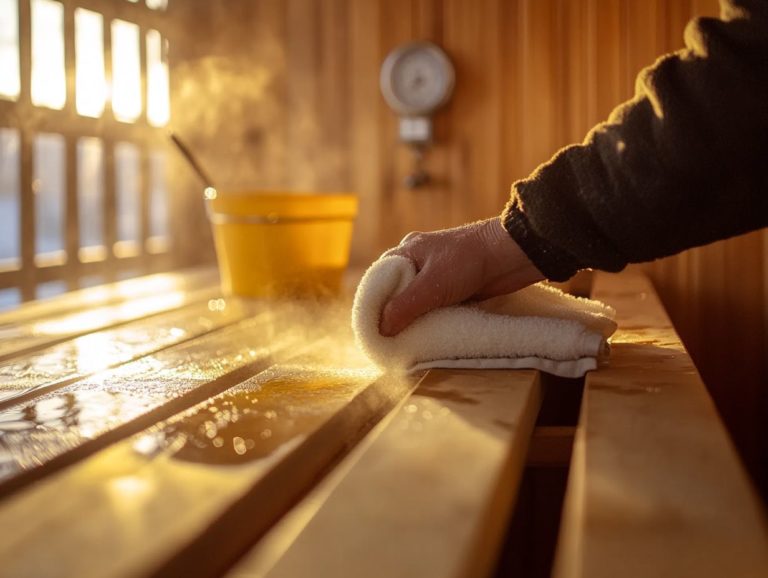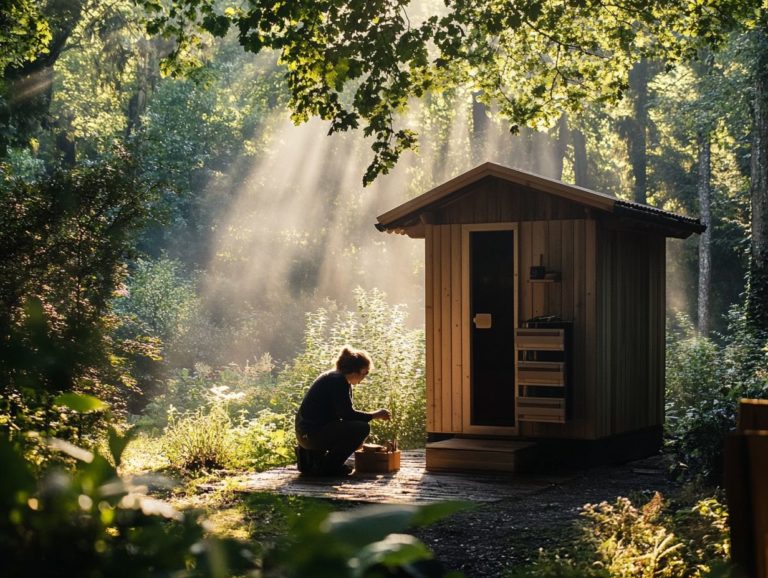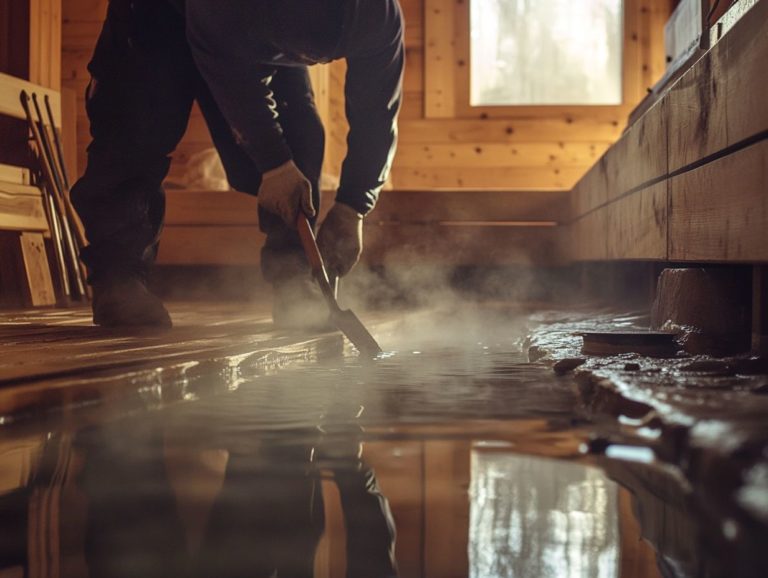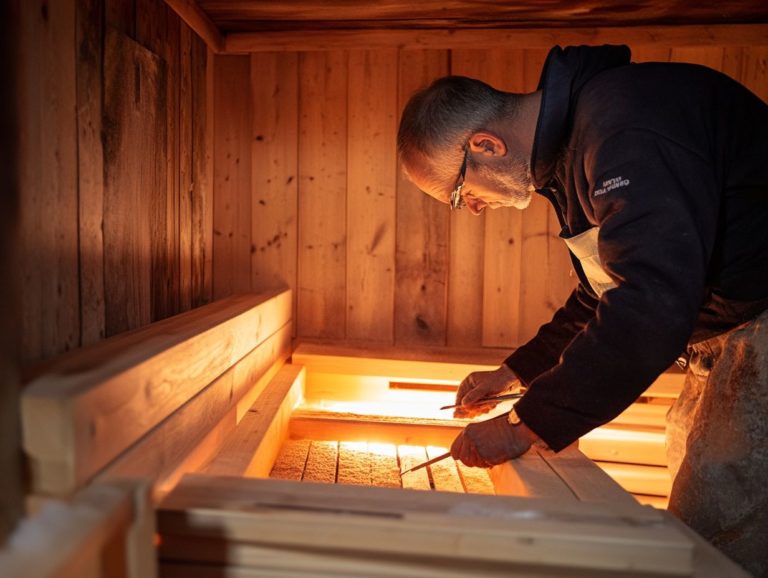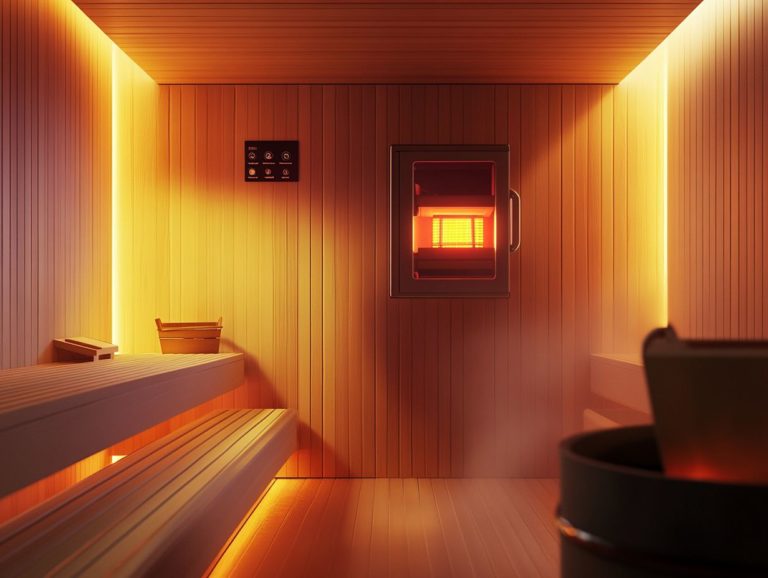Understanding the Lifespan of Sauna Components
Saunas offer a unique blend of relaxation and health benefits. Understanding their components and maintenance is key to enjoying these advantages.
Explore different sauna types, discover their essential parts, and learn why regular upkeep is vital.
Learn how the frequency of use and material quality affect your sauna’s longevity.
Get practical tips to keep your sauna in top-notch condition for years!
Immerse yourself in this knowledge to ensure your sauna remains a peaceful sanctuary.
Contents
- Key Takeaways:
- Overview of Saunas
- The Importance of Sauna Maintenance
- Factors that Affect the Lifespan of Sauna Components
- Common Sauna Components and Their Lifespan
- Tips for Extending the Lifespan of Sauna Components
- Frequently Asked Questions
- What maintenance does a sauna require?
- How often should I replace sauna components?
- Can I use regular cleaning products in my sauna?
- Why is routine maintenance important?
- What factors affect the lifespan of sauna components?
- How often should sauna components be replaced?
- What are the signs that indicate it’s time to replace sauna components?
- Can sauna components be repaired instead of replaced?
- How can I prolong the lifespan of my sauna components?
- Is it necessary to clean sauna components?
Key Takeaways:
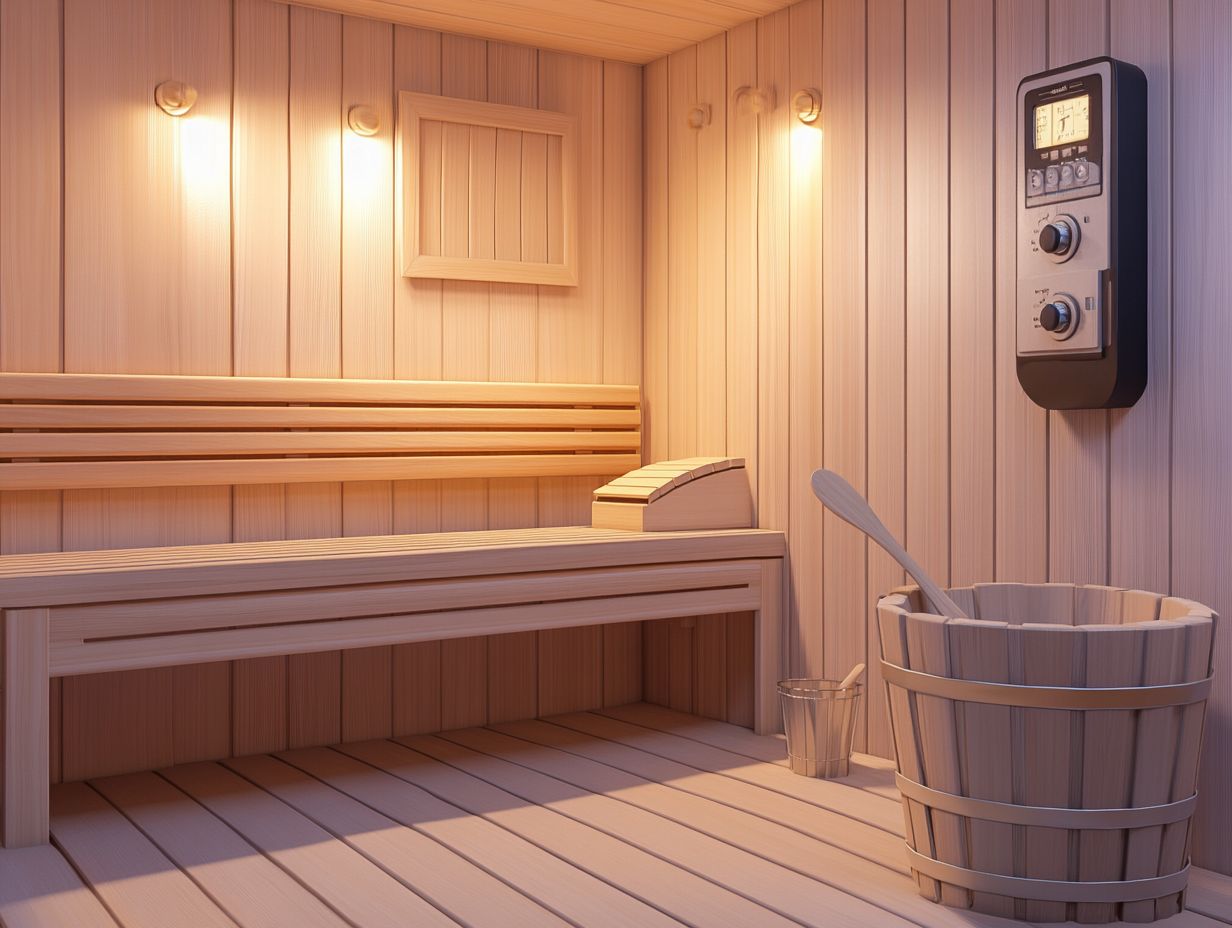
- Proper maintenance is crucial for extending the lifespan of sauna components. This ensures a safe and enjoyable sauna experience.
- The frequency of use, environmental conditions, and material quality all influence how long sauna components last.
- Regular cleaning and timely replacement or upgrading of components can greatly extend your sauna s lifespan and save you money.
Overview of Saunas
Saunas are a staple of wellness culture, known for their ability to promote relaxation and detoxification.
You can find these heat therapy havens in various forms. Traditional saunas use heated rocks, while infrared saunas employ advanced technology to provide therapeutic heat.
Reputable companies like Divine Saunas and Dundalk Leisurecraft ensure top-notch quality in sauna craftsmanship.
Familiarize yourself with different sauna types and their benefits to elevate your sauna experience.
Types and Components
There are two main sauna types: traditional and infrared. Traditional saunas rely on heated rocks, while infrared saunas use light to warm your body directly.
Essential components include heaters, wooden slats, and accessories that enhance your experience. Adding features like plunge tubs can elevate your relaxation package.
Traditional saunas create a humid atmosphere using wood-burning or electric heaters. You can even pour water on the rocks for extra steam.
Infrared saunas emit infrared light, heating your body rather than the surrounding air, providing comfort at lower temperatures.
Benefits go beyond relaxation; many users report improvements in circulation and skin health. Accessories like aromatic oils, towels, and calming music can enhance your sauna experience.
The Importance of Sauna Maintenance
Regular maintenance is essential for your safety and enjoyment. It directly impacts your sauna’s longevity and performance.
By establishing a consistent cleaning routine and hygiene protocols, you can prevent mold growth and maintain optimal moisture levels.
Good maintenance improves appearance and amplifies the health benefits you gain from using a sauna.
Why Regular Maintenance is Necessary
Regular maintenance is essential for the best sauna experience! It prevents mold growth, extends the life of your sauna components, and ensures a hygienic environment for all users.
By sticking to a consistent cleaning routine, you can effectively eliminate bacteria and other pathogens, resulting in a significantly healthier sauna experience.
Embracing sauna longevity tips will help you maintain the structure and performance of your equipment, ultimately enhancing user satisfaction.
Don’t wait neglecting these practices can lead to serious problems, from unpleasant odors to deteriorating materials, which can seriously compromise the overall experience.
When components aren t regularly inspected and cared for, the risk of costly repairs and replacements skyrockets.
Regular upkeep not only prevents these issues but also improves air quality, making each session more enjoyable and safe for everyone involved.
By prioritizing hygiene and preventive measures, you create a more inviting atmosphere that encourages users to return while promoting the longevity of your investment in wellness.
Factors that Affect the Lifespan of Sauna Components
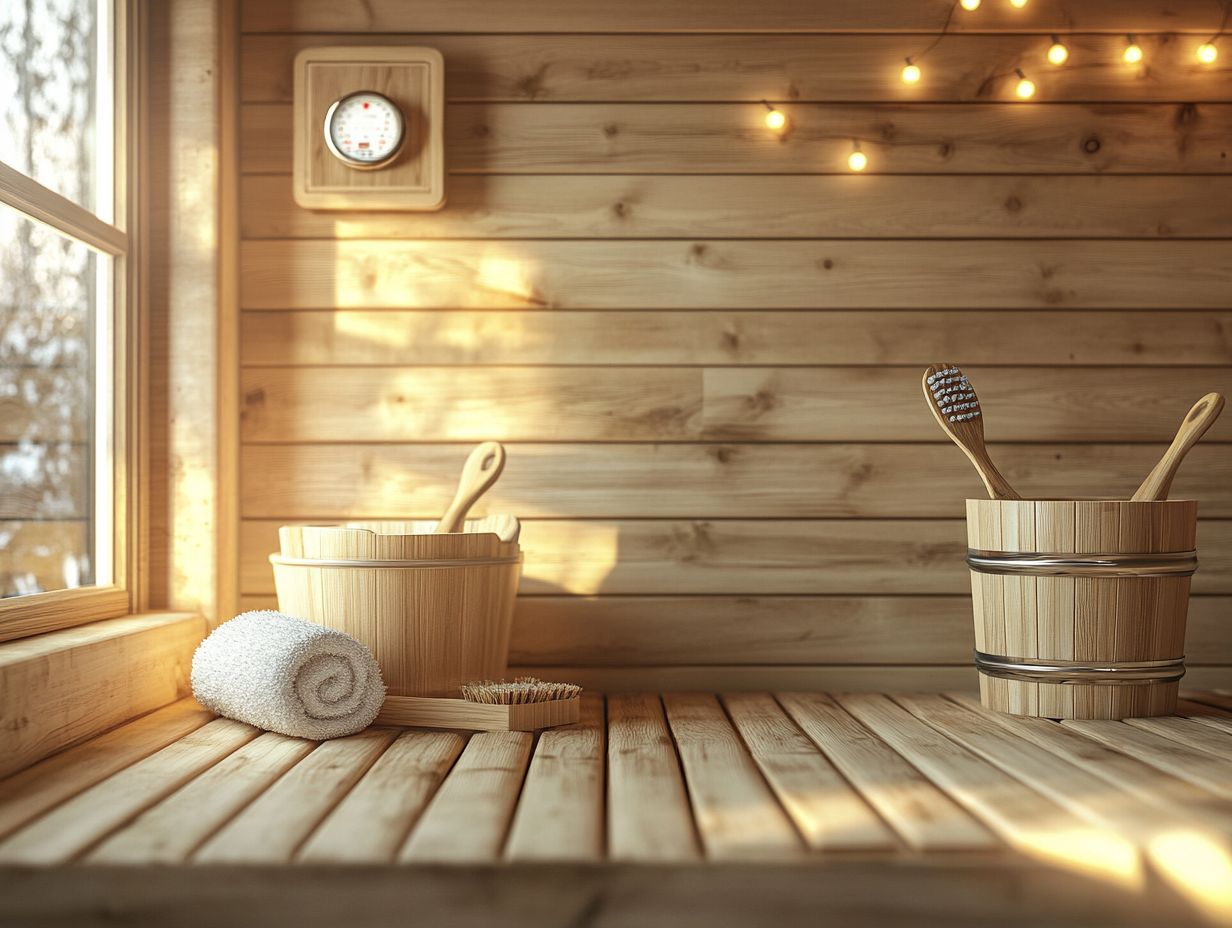
Several factors are essential in determining the lifespan of sauna components, including:
- How often you use the sauna
- The quality of materials used in its construction
- The maintenance practices you employ
Regularly inspecting the heater and ensuring proper ventilation are vital aspects of sauna care that can greatly enhance the durability of both indoor and outdoor saunas.
By understanding these factors, you can take better care of your sauna and significantly improve your sauna experience.
Usage Frequency and Conditions
The frequency with which you use your sauna directly affects its performance and longevity. Frequent sessions can lead to increased wear and tear on its components.
The conditions inside the sauna such as controlling moisture and ensuring proper ventilation are essential for maintaining optimal performance and preventing issues like mold and bacteria growth.
Each session can bring high humidity levels that may impact the wooden surfaces and electrical components if not meticulously managed. Effective moisture management means keeping an eye on humidity levels; too much moisture can lead to decay and deterioration.
Proper ventilation is crucial. A well-ventilated sauna ensures adequate air exchange, which reduces dampness and fosters a healthier environment.
Consider positioning vents wisely and using fans to circulate air. This not only enhances your comfort but also extends the lifespan of your sauna equipment.
Type and Quality of Materials
The type and quality of materials you choose for sauna construction play a crucial role in defining its overall quality and lifespan.
Opting for premium materials like cedar wood is a smart move; its durability and natural resistance to moisture make it particularly well-suited for sauna environments.
By giving proper care and treatment to the wood, you can further enhance the longevity of your sauna components, ensuring that every session remains a consistently enjoyable experience.
Along with cedar, consider other wood types, such as hemlock and spruce. Each offers distinct characteristics to align with your aesthetic preferences and functional needs.
Hemlock is renowned for its stability and cool touch, while spruce brings a lighter hue and a pleasant aroma to the mix.
It s vital to weigh these qualities carefully when selecting materials, as they can dramatically influence the atmosphere and efficiency of your sauna.
Choosing treated wood is another wise choice; it helps prevent issues like warping or cracking, which can compromise both the sauna s performance and your overall enjoyment.
Make maintenance a priority today for a healthier, more enjoyable sauna experience tomorrow!
Common Sauna Components and Their Lifespan
Grasping the essential components of a sauna and their lifespans is vital for maintaining and caring for your sauna effectively. Key elements such as the sauna heater, doors and seals, benching and flooring, along with the electrical and control systems, each come with their expected lifespans and unique maintenance requirements.
By concentrating on these aspects, you can adopt strategic tips for enhancing your sauna’s longevity, ultimately elevating your overall experience.
Heaters
The sauna heater is a pivotal element that directly influences your sauna’s performance and overall experience, whether you’re enjoying an infrared sauna or a traditional wood-burning model. Regularly inspecting the heater is essential to ensure it operates efficiently and lasts longer. Neglecting this can lead to performance hiccups and reduced heating efficiency.
Get to know your heater types for a better sauna experience! Electric heaters deliver consistent warmth and are often easier to maintain. In contrast, wood-burning options provide a more authentic ambiance, but require more upkeep, such as cleaning the chimney of the wood-burning heater and managing firewood.
Infrared heaters, celebrated for their energy efficiency, also require periodic checks of their electrical components to ensure they re functioning optimally. Regular inspections help you catch issues early, preventing costly repairs and enhancing your overall sauna experience.
Investing your time in proper maintenance routines for these heater types will yield significant benefits in performance. Check your heater today for optimal performance!
Doors and Seals
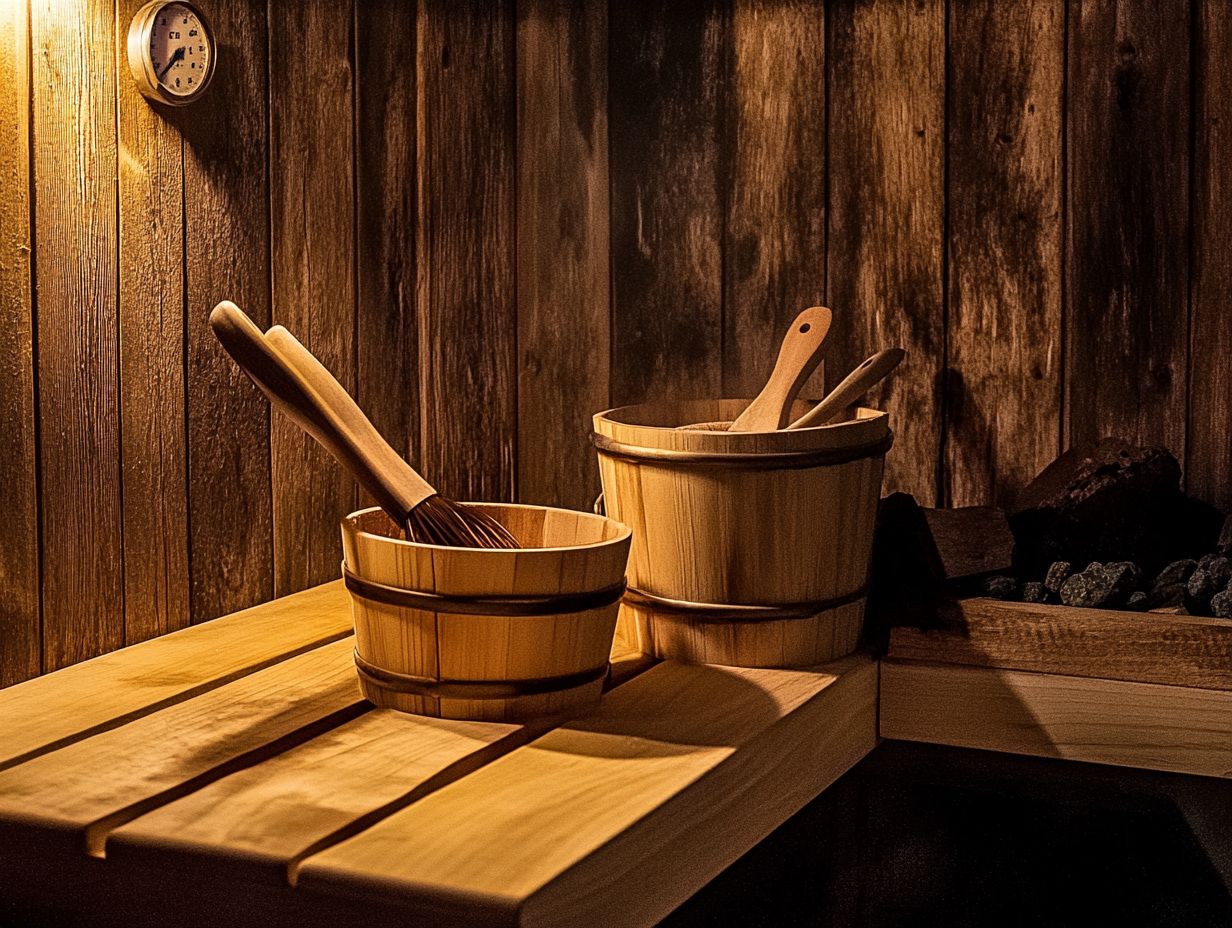
Doors and seals play a crucial role in maintaining the optimal sauna environment by effectively preventing heat loss and managing moisture. A well-fitted door and effective seals significantly enhance the sauna’s performance and user comfort. This makes regular maintenance and checks essential to preserve these vital components.
As time goes by, wear and tear can take their toll on these elements, leading to increased energy costs and an uncomfortable atmosphere. Ensuring that your doors close tightly and that seals remain intact helps maintain the desired temperature and reduces the risk of mold and mildew, which thrive in damp conditions.
Proper ventilation is equally important, as it allows fresh air to circulate, creating a healthier sauna experience. By regularly inspecting these integral features and following ventilation tips, you ensure their longevity and efficiency. This allows everyone to fully enjoy a revitalizing sauna experience.
Benching and Flooring
Benching and flooring are essential elements that not only influence the quality of your sauna but also play a pivotal role in its hygiene. By selecting durable materials and utilizing proper wood treatment techniques, you can ensure these surfaces endure the sauna’s high temperature and humidity levels, enhancing your overall sauna experience.
Attention to detail in these aspects is crucial. High-quality woods like cedar wood or hemlock are often preferred for their natural resistance to decay and their ability to maintain structural integrity over time.
Regular maintenance, including appropriate cleaning routines and preventive treatments, is key to preserving both the aesthetic and functional qualities of these surfaces. Daily post-use cleaning is also crucial. A well-maintained sauna not only extends its longevity but also guarantees a hygienic environment, free from mold and mildew.
Ultimately, investing in quality materials and adhering to proper care practices significantly elevates the appeal and effectiveness of your sauna experience, ensuring it meets the highest sauna hygiene standards.
Electrical and Control Systems
Electrical and control systems are crucial for regulating temperature and ensuring the seamless operation of sauna heaters and sauna technology. Prioritizing proper maintenance and routine inspections of these systems maximizes sauna performance and helps avert potential electrical issues.
These systems form the backbone of your sauna experience, providing sauna users with a comfortable and safe environment that promotes relaxation and wellness. Regular checks on components like thermostats improve accuracy and reliability, which directly influence the sauna’s heating efficiency, highlighting the importance of sauna safety.
Malfunctions in these systems can lead to inconsistent temperatures and even safety hazards, highlighting the importance of vigilance. Ensuring that connections and wiring are free from wear and corrosion significantly extends your sauna’s lifespan and enhances its performance.
Investing in routine maintenance enhances performance and ensures that your sauna operates at peak efficiency, delivering the ultimate experience for users while ensuring long-term sauna longevity.
Tips for Extending the Lifespan of Sauna Components
Extending the lifespan of your sauna components hinges on a thoughtful blend of effective cleaning and maintenance techniques, paired with timely replacements and upgrades. Embracing these sauna longevity tips not only enhances performance but also ensures a consistently enjoyable experience.
This approach helps preserve the quality and functionality of your investment, allowing you to relish every moment spent in your indoor sauna or outdoor sauna.
Proper Cleaning and Maintenance Techniques
Implementing an effective cleaning routine is essential for maintaining your sauna, ensuring a hygienic environment and extending the lifespan of its components. Using antimicrobial towels and adhering to specific hygiene practices, including towel management, significantly reduces the risk of mold and bacteria, enhancing your sauna experience.
To further elevate cleanliness, consider using natural cleaning solutions like vinegar and baking soda. These eco-friendly options tackle stubborn stains and odors. Clean the sauna surfaces after each use by wiping down benches, walls, and floors to eliminate sweat residues and bacteria this is key to your daily maintenance.
Incorporating a deep cleaning session every month helps preserve the wood s integrity, preventing deterioration and ensuring a delightful aromatic experience. Using essential oils like eucalyptus or tea tree enriches the atmosphere while boasting natural antibacterial properties, contributing to the overall hygiene of your sauna and enhancing the health benefits of your sauna experience.
Replacement and Upgrading Options
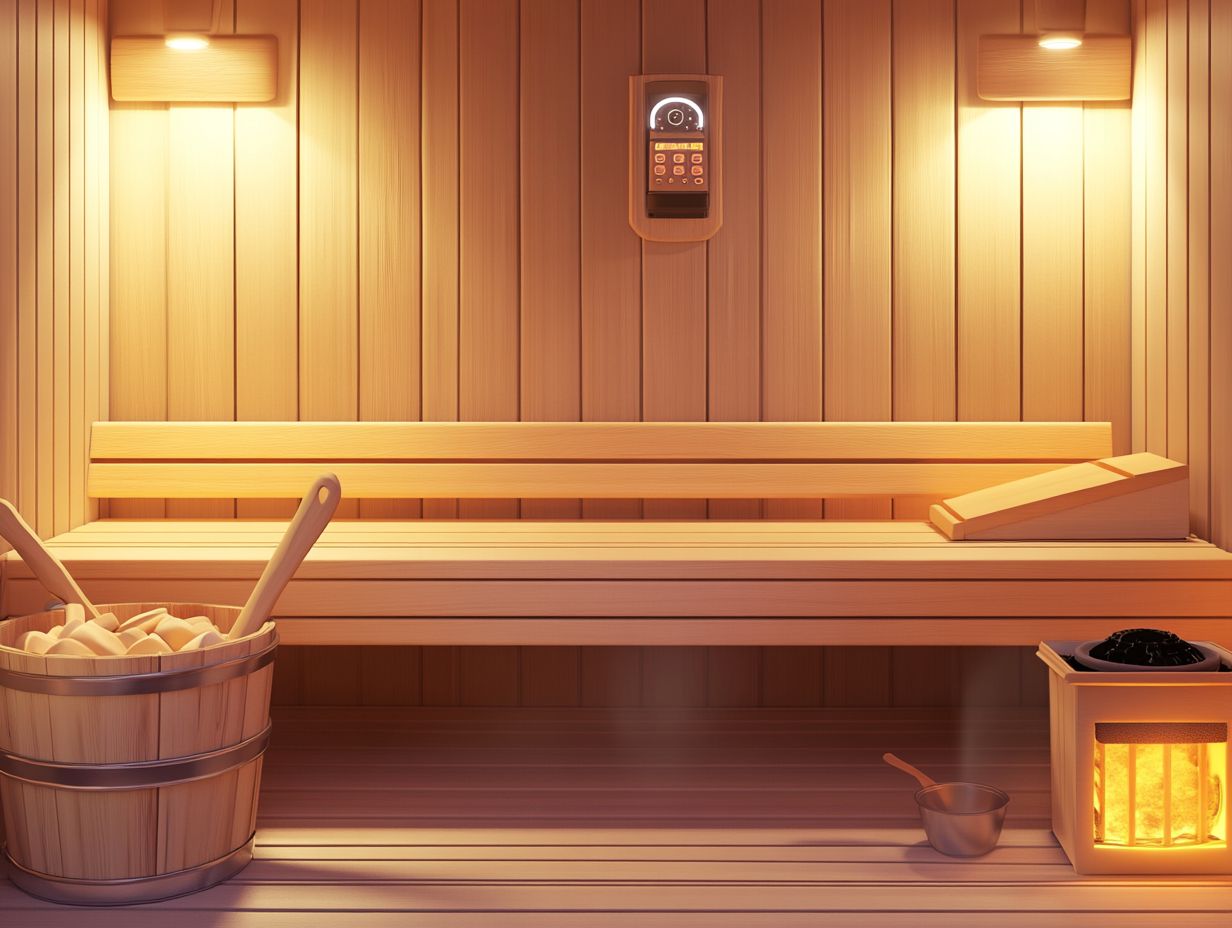
Knowing when to consider replacement and upgrading options for your sauna components significantly impacts its performance and your overall experience. Whether you’re contemplating an upgrade to a premium sauna heater or replacing worn-out accessories, making informed decisions is key to ensuring your sauna investment continues to deliver health benefits.
Recognizing the signs that components are nearing the end of their service life helps you avoid unexpected downtime and enhances efficiency. Timely replacements elevate heating capabilities, while modern accessories like sauna products enhance both comfort and aesthetic appeal.
Investing in high-quality materials maximizes thermal efficiency and contributes to the longevity of your sauna environment. These thoughtful upgrades enhance your overall experience, ensuring that each session remains enjoyable and beneficial for your physical and mental well-being, whether you’re using an infrared sauna or a traditional sauna.
Frequently Asked Questions
What maintenance does a sauna require?
Regular maintenance includes cleaning the surfaces, checking electrical connections, and inspecting components for wear and tear.
How often should I replace sauna components?
Replace sauna components based on their wear and tear, typically every few years, depending on usage.
Can I use regular cleaning products in my sauna?
It’s best to use natural cleaning solutions like vinegar and baking soda to avoid damaging the sauna materials.
Why is routine maintenance important?
Routine maintenance ensures safety, enhances performance, and extends the lifespan of your sauna.
Don’t wait! Regular maintenance today ensures a stress-free sauna experience tomorrow. Join the sauna revolution today!
What factors affect the lifespan of sauna components?
The lifespan of sauna components depends on how often you use them, the quality of materials, and how well you keep the sauna clean.
How often should sauna components be replaced?
Replacement frequency varies by component. For instance, sauna rocks need replacing every 2-3 years, while sauna heaters can last up to 10 years.
Regular inspections help you know their condition.
What are the signs that indicate it’s time to replace sauna components?
Look for rust, unusual noises, or poor performance. These signs usually mean it s time for a replacement.
Can sauna components be repaired instead of replaced?
Sometimes, you can repair sauna components instead of replacing them. Always consult a professional to find the best solution.
How can I prolong the lifespan of my sauna components?
Want to keep your sauna components lasting longer? Stick to good maintenance practices and use high-quality materials.
Is it necessary to clean sauna components?
Yes! Regular cleaning prevents bacteria and debris build-up, which can cause early deterioration and promote mold growth.


